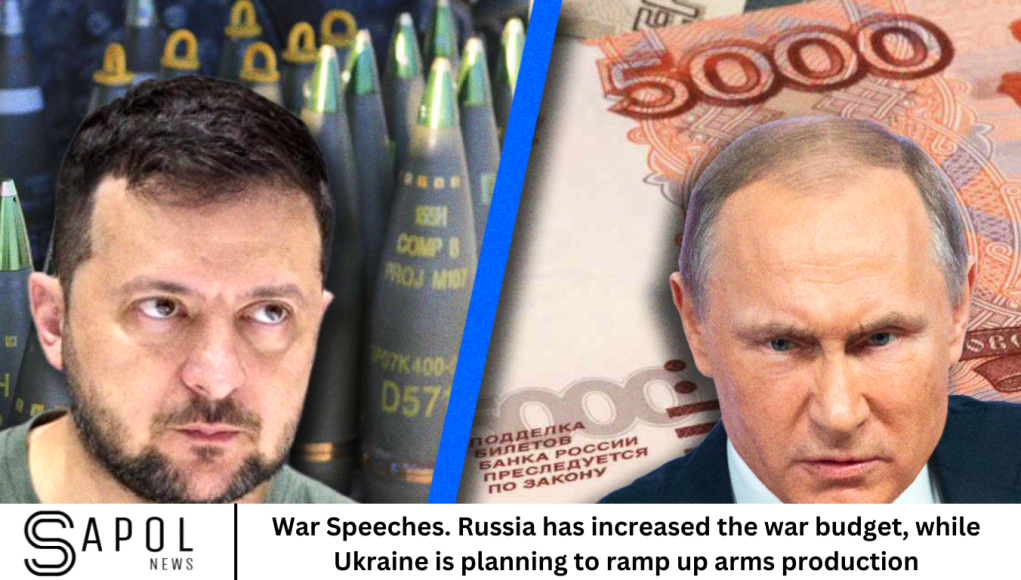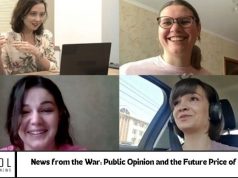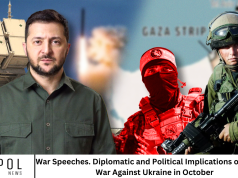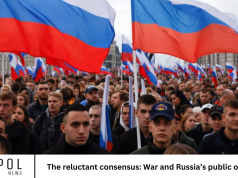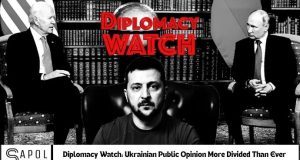Last week (September 25 – October 1), Ukraine announced the creation of the Defense Industries Alliance for weapons manufacturing. The Kremlin hasn’t given up on its imperial ambitions and threatens to capture new territories. For this purpose, the aggressor state plans to spend more than a third of its federal budget funds on the war.
Despite the growing national debt, Russia still manages to finance the war against Ukraine by way of partially circumventing the sanctions and using third-country companies to import military goods.
Ukraine’s partners are making efforts to prevent Russia from bypassing sanctions, but the task of enforcing restrictions against Moscow requires closer attention from national governments and the development of a strategy for strengthening sanctions on a permanent basis.
Ukraine is creating an Alliance for weapons production and is working on the matter of strengthening its air defense capabilities
On September 28, NATO Secretary General Jens Stoltenberg made an unannounced visit to Kyiv and met with Volodymyr Zelensky to discuss the issues of Euro-Atlantic integration and provision of military assistance to Ukraine. In particular, they talked about the need to strengthen Ukraine’s air defense capabilities before winter comes because Russia is expected to resume attacks on Ukrainian energy infrastructure.
Stoltenberg emphasized that at the Vilnius summit, which was held in July 2023, all members of the Alliance agreed that Ukraine will join NATO. According to NATO Secretary General, the Alliance made a historic decision to shorten Ukraine’s path to NATO by removing the requirement to implement a Membership Action Plan.
Stoltenberg also underlined that NATO member countries continue to provide Ukraine with state-of-the-art capabilities and military equipment, including tanks, missile systems and air defenses, as well as training for F-16 pilots. “This is a collective effort by all NATO allies,” the Secretary General said, noting that of nearly 100 billion euros in military support committed to Ukraine since last year, almost half has come from European NATO allies and Canada.
In his turn, Volodymyr Zelensky told that he discussed key defense issues with NATO Secretary General. “It is necessary to strengthen the air shield of Ukraine. We discussed the situation in connection with expected Russian attacks on Ukraine’s energy infrastructure,” the President said.
On September 28, the French Defense Minister Sebastien Lecornu and UK Defense Secretary Grant Shapps also came on a visit to Kyiv. According to Volodymyr Zelensky, the parties discussed the intensification of training of Ukrainian soldiers, the general strategy for winning a war, as well as the possibility of joint production of weapons that are necessary for Ukraine and its partners.
According to New York Times, NATO member countries are planning to pump up weapons production in Ukraine. The journalists believe that the visits of Stoltenberg as well as French and British defense ministers to Kyiv are closely connected with this plan. According to NYT publication, localization of weapons production is a potentially lucrative prospect for Western manufacturers that will contribute to the economic development of Ukraine.
The U.S. Permanent Representative to NATO Julianne Smith said that there is a shortage of some weapons and ammunition due to the ongoing hostilities, and the NATO allies have provided Ukraine with everything they could. Therefore, NATO is developing a plan for the production of the required amount of scarce ammunition for Ukraine and members of the Alliance.
Meanwhile, German arms manufacturer “Rheinmetall” has confirmed that it received permission from Germany’s Federal Cartel Office to set up a joint venture with the “Ukrainian Defense Industry”. The joint venture will be based in Kyiv and perform maintenance of military equipment received by Ukraine from Germany and other partner countries, as well as assembling, manufacturing and development of new military vehicles. It has also been reported that the industrial conglomerate “Czechoslovak Group” and “Ukrainian armor” are considering the possibility of joint production of the ASCOD infantry fighting vehicles in Ukraine.
On September 30, the first International Forum of Defense Industries (DFNC1) took place in Kyiv, bringing together representatives of 252 companies from more than 30 countries producing a full range of weapons and defense systems. At the Forum, Volodymyr Zelensky announced the creation of the Defense Industries Alliance and the establishment of special Defense Fund. According to the Ministry of Foreign Affairs of Ukraine, 38 companies from 19 countries had already joined the Alliance by the time the Forum closed.
“Ukrainian companies signed 20 documents with foreign partners. These are agreements and memoranda on the manufacture of drones, repair and production of armored vehicles and ammunition. Cooperation formats include joint production, exchange of technologies and supply of components,” the MFA of Ukraine said in a statement.
According to the President of Ukraine, the special Defense Fund will be replenished through the use of dividends of state-owned defense enterprises and profits from the sale of confiscated Russian assets. The Fund will provide resources for the development of military production and cooperation, creation of new military facilities and implementation of programs necessary for the defense of Ukraine and well-being of Ukrainian soldiers.
Russia maniacally threatens to capture more Ukrainian territories and prepares itself for a long war
585 days since the start of full-scale war, the Russian Federation still wants to speak from a position of strength and spares no human or financial resources. In an interview with TASS news agency, the Minister of Foreign Affairs of the aggressor state Sergey Lavrov said that Russia is ready to come to terms, but taking into account the “realities on the ground” and Russia’s security interests.
That said, Russia has already set a timeline for accomplishment of the “tasks of special operation” through military means. For example, Russian Defense Minister Sergey Shoigu spoke at the meeting of Defense Ministry’s Collegium and stated that the Russian army continues increasing its combat capabilities which will allow Russia to achieve the “target goals” by 2025. For this purpose, Russia plans to allocate a record 11 trillion rubles for the army in 2024 – roughly one-third of the federal budget, which means that Russia’s defense spending will hike by 68% compared to 2023.
Moreover, Russian authorities threaten to capture more Ukrainian territories and increase the number of “new regions” in the composition of the Russian Federation. “Special military operation will continue until the total destruction of Nazi Kyiv regime,” Dmitry Medvedev said.
The Kremlin intends to continue using the services of volunteer units and private military companies in order to increase the size of its armed forces. In particular, on September 29, Vladimir Putin instructed “Wagner” group ex-commander Andrey Troshev to take on the task of forming new “volunteer units”.
Furthermore, Putin signed a decree on autumn military conscription. A total of 130,000 people are to be called up for mandatory military service in the October-December timeframe. Although Russian conscripts are not supposed to participate in the war, the legislators entitled them to sign a contract with the Ministry of Defense and go fight for Kremlin’s imperial ambitions upon completion of first month of mandatory military service. It seems that the Russian authorities are doing everything to delay the start of mass mobilization.
At the same time, the Russian authorities are trying to regain the initiative on the battlefield. According to a Kremlin insider source cited by the Institute for the Study of War, Putin reportedly gave Sergey Shoigu a deadline of one month (until early October) to improve the situation on the frontline and stop Ukrainian counteroffensive in its tracks.
However, judging by the current situation on the frontline, the Armed Forces of Ukraine are well on the way to achieving the goals of their offensive operation. The latest statements made by representatives of the defense agencies of Ukraine’s allies drew the ire of Russian officials. In particular, UK Defense Secretary Grant Shapps said that the government wants to send military instructors to Ukraine, while the chair of the Defense Committee at the German Bundestag emphasized that Ukraine has the right to launch long-range Taurus missiles on Russian territory.
In response, Dmitry Medvedev threatened to destroy British instructors and German factories that produce missiles: “These idiots are actively pushing us towards a third world war…” However, later on the Prime Minister of Great Britain Rishi Sunak ruled out the possibility of sending British military specialists to Ukraine – at least in the near future.
Office of the President of Ukraine is convinced that the Kremlin’s bravura statements are nothing more than mere ambitions. Mykhailo Podolyak, who is an advisor to the head of the Office of the President of Ukraine, emphasized that “the post-Soviet Russia in the Putin era is a large factory for the production of exported ‘show offs’ that are a way of hypercompensating for their own complexes.”
The Kremlin is constantly trying to convince the domestic audience that the “special military operation” is a success. For this purpose, Russian authorities established a “memorable date” – September 30 – to celebrate the annexation of part of Ukraine’s territory.
“You preserved and passed on your love for the Motherland to your children. Thanks to you as well as your firmness and determination, Russia has become even stronger,” Putin said in a video message on the occasion of the “day of reunification” of the Russian Federation with four oblasts of Ukraine.
Despite the numerous international crimes it has committed, Russia continues to consider itself a country that shares common European values. Russia diverts attention away from the atrocities committed by its armed forces in Ukraine through the use of propaganda tools and manipulation of public opinion.
Nevertheless, international investigative bodies have found more evidence of Russian war crimes. Independent international commission on investigation of crimes in Ukraine has confirmed that the Russian military resorted to brutal methods of torture as well as committed rape and sexual violence against Ukrainians. The Commission has also admitted the possibility of Russia’s genocide of Ukrainians and incitement to genocide.
Russia’s economy and military-industrial complex: sanctions against Russia are working, but it is necessary to take a more systematic approach and tighten sanctions
Ukraine’s allies continue to exert economic pressure on Russia with the aim of limiting Russia’s ability to wage the war against Ukraine. The federal budget of the aggressor state is already feeling the negative impacts of sanctions: Russia’s national debt has increased by 2.2 rubles over the first six months of 2023, although the planned debt figure for the entire year was 2.5 trillion rubles. As of July 1, 2023, the amount of borrowing exceeded 25 trillion rubles, which is approximately 16.7% of the projected volume of GDP, while the costs of national debt servicing have increased by 4% to 718.1 billion rubles as compared to mid-2022.
At the same time, Russia still manages to get oil and gas revenues. Russian oil continues to rise in price despite a $60 per barrel price cap imposed by the G-7 countries and its allies: Urals oil grade is trading at $85.35 a barrel from the Baltic port of Primorsk and $86 from the Black Sea port of Novorossiysk.
According to Bloomberg, Russia has assembled a so-called “shadow fleet” of tankers operating outside jurisdictions of countries that imposed sanctions in order to bypass the oil price cap. According to Financial Times, such a “shadow fleet” is capable of operating without Western insurance and other services. This allowed Moscow to increase the export prices for its oil in the face of fierce competition on the world market.
Furthermore, approximately two-thirds of Russian crude and petroleum products are being transported with the help of European companies. In order to avoid sanctions, European service providers must obtain appropriate attestations to confirm that the cargo was purchased at a below $60 per barrel cap price, but the majority of them rarely have an idea of the true value of the cargo.
“More than by the use of ‘shadow fleet’, the impact of the oil price cap has been undermined by a failure of the participating governments to fully enforce the price cap and punish violators,” Bloomberg noted, citing a report by the Center for Research on Energy and Clean Air.
According to Reuters, Russian producers have restarted regular exports of propane and butane via the Crimean port of Kerch after an eight-year hiatus, despite security threats. The resumption of exports highlights Russia’s ability to cope with international sanctions.
Last week, it has also transpired that the German-Japanese machine tool manufacturer DMG MORI located in Ulyanovsk continues selling its goods to the Russian military-industrial complex and other companies that were slapped with Western sanctions. Since the start of the full-scale war, this industrial plant has been playing an important role in the Russian Federation because Russia’s weapon production industry is absolutely dependent on Western machinery. In March 2022, DMG MORI announced its withdrawal from Russia, but this actually didn’t happen. According to “Agentstvo” project, the German-Japanese manufacturer is no longer selling its machine tools directly but through a network of associated companies.
The military industry of the Russian Federation is spurred on by the use of companies located in third countries, which has become common practice. Western partners of Ukraine are working to prevent the export of sanctioned goods to the aggressor state.
On September 25, the U.S. Department of Commerce announced the imposition of trade restrictions against 11 Chinese and 5 Russian companies that were involved in the delivery of components necessary for the production of Russian drones. On September 27, the Office of Foreign Assets Control of the U.S. Department of the Treasury imposed sanctions on 5 legal entities and 2 private individuals registered in Iran, China, Hong Kong and Turkey. All of them participated in the purchase of components for the production of Iranian UAVs.
In its turn, Brussels has warned European companies and governments that it could ban the sale of certain goods to Turkey, India, Kazakhstan, Uzbekistan, Vietnam, Costa Rica and other countries from where Iran and Russia are sourcing parts for drones and other weapons. Customs information has shown that all the imports to Iran and Russian originated from these countries.
According to the European Commission, the revealed facts go to show that EU sanctions are creating “significant pressure”, but at the same time it is necessary to step up efforts.
Currently, the European Commission is cooperating with third-country jurisdictions to prevent the circumvention of sanctions, but if diplomatic efforts prove insufficient, the EU will stop the export of specific goods and prohibit the provision of related services to these third countries.
As has been stated by the President of Kazakhstan Kassym-Jomart Tokayev in Germany, the leaders of third countries can support the sanctions imposed against the aggressor state. However, it is necessary for the national governments to perform systematic work in order to identify and curb the companies that ignore sanctions and help Russia to wage the war of aggression against Ukraine.
Frequently Asked Question
Why has Russia increased its war budget?
Russia has increased its war budget to sustain and enhance its military efforts, particularly in light of ongoing conflicts, including the war in Ukraine. The increase is aimed at bolstering defense spending, upgrading military equipment, and supporting the ongoing operations.
How is Ukraine planning to ramp up arms production?
Ukraine is focusing on increasing its domestic production of weapons and military equipment. This is part of an effort to become less dependent on foreign arms supplies and to enhance its self-defense capabilities in the face of Russian aggression.
What does a war speech typically aim to achieve?
War speeches are usually delivered by political leaders or military officials to rally support, inspire patriotism, justify military actions, and ensure continued funding for defense efforts. They often serve to maintain morale among citizens and troops.
What are the main themes in Russia’s war speeches?
Russian war speeches typically emphasize national security, the defense of Russian sovereignty, and the protection of Russian-speaking populations. Leaders also use such speeches to frame their actions as responses to perceived threats from the West or NATO.
How do Ukraine’s war speeches reflect their strategy?
Ukraine’s war speeches often focus on the defense of their sovereignty, territorial integrity, and the need for international support. Ukrainian leaders emphasize the importance of resisting aggression and protecting their democratic values.
What role do war speeches play in international diplomacy?
War speeches can play a significant role in shaping international public opinion, influencing diplomatic negotiations, and signaling a country’s commitment to its military goals. They can be used to justify actions to the global community or rally international allies.
How do war speeches impact domestic support for the war effort?
War speeches are designed to bolster domestic support by framing the conflict in a way that unites the population behind the cause. In both Russia and Ukraine, these speeches aim to maintain public morale, secure funding, and encourage citizens to back their governments’ military efforts.
Conclusion
The increase in Russia’s war budget and Ukraine’s plans to ramp up arms production reflect the intensifying nature of the conflict and the need for both countries to strengthen their military capabilities. War speeches from both sides serve as vital tools to rally domestic support, justify military actions, and influence international perceptions. These speeches are not just about the immediate war effort; they also shape the political narrative, boost morale, and demonstrate commitment to their respective causes. As the war continues, the role of military spending, arms production, and public rhetoric will remain crucial in determining the course of the conflict.

